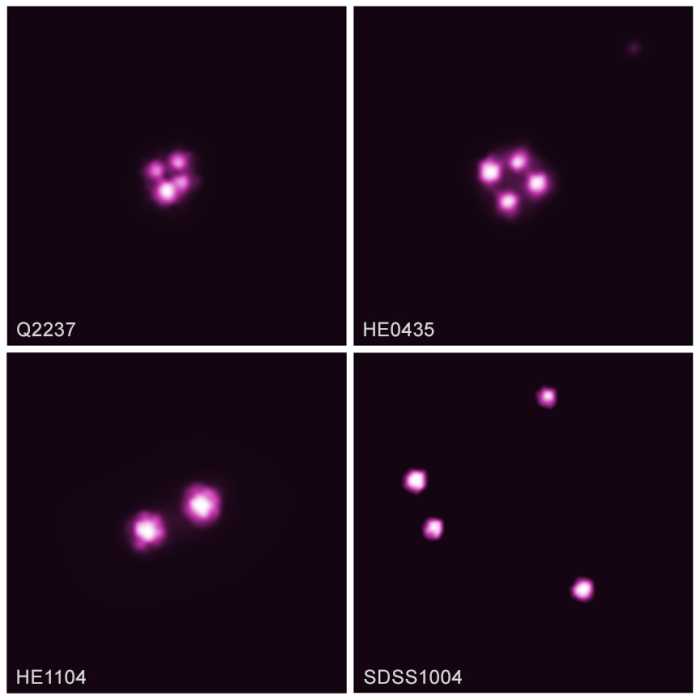
The Chandra images show pairs of huge bubbles, or cavities, in the hot gaseous atmospheres of the galaxies, created in each case by jets produced by a central supermassive black hole. Credit: X-ray: NASA/CXC Illustration: CXC/M. Weiss
The turn of mammoth plates of residue and gas whirling into supermassive dark openings billions of light-years away may sound like a troublesome thing to gauge, yet stargazers have figured out how to do it.
Utilizing another procedure, specialists have decided the turn of five gradual addition circles - finding that one, in a quasar called the Einstein Cross, is dashing around at more than 70 percent of the speed of light.
Everything comes down to perceptions in X-beam wavelengths, joined with a vast impact called gravitational lensing.
It couldn't be any more obvious, there's some stuff in the Universe that has so much mass that it creates an amazing gravitational field around it. Monstrous worlds and bunches of universes, for example.
At the point when the light behind that field goes through it, the gravitational power is solid to such an extent that it twists the way of the light. This is the thing that gravitational lensing is: the place bowed light makes numerous pictures of an article, enabling us to see subtleties that would somehow or another have been too far off to even think about making out.
This impact is extremely convenient for space experts, and there are many lensed items out there that have given us understanding into the Universe's development, including lensed quasars.
These are among the most splendid articles in the Universe: very glowing galactic centers fueled by effectively sustaining supermassive dark gaps. As the gradual addition plate of material twirls around the dark gap, its grating produces such extreme radiation that we can see it even from billions of light-years away.

Chandra observations of lensed quasars. (NASA/CXC/Univ. of Oklahoma/X. Dai et al.)
At the point when seen through a gravitational focal point, we can see much more prominent detail.
In this examination, to figure the revolution pace of five of these lensed quasars (extending between 8.8 billion to 10.9 billion light years away), the exploration group added a last pivotal fixing to help check their turn: microlensing.
This is much the same as cosmic system scale lensing, yet littler, utilizing the lensing impact made by individual stars in the lensing world, as opposed to universes or groups of worlds. The strategy makes extra amplification - which, thus, implies that a littler district must deliver the X-beam outflow watched.
We realize that a turning dark gap hauls space-time around with its revolution: a marvel called outline hauling. This implies the internal edge of the growth plate can circle nearer to the dark opening than for a dark gap that isn't turning. The quicker the dark opening's twist, the closer the circle.
X-beams are produced when the quickly turning accumulation plate makes a high-temperature crown over the circle, near the dark gap. These X-beams reflect off the internal edge of the accumulation circle, and are misshaped by the dark gap's gravitational powers.
A littler area of X-beam outflow infers an exceptionally tight circle, which, thus, implies the dark opening must turn really quick. In view of perceptions taking utilizing NASA's Chandra X-beam Observatory, this is the thing that the group used to figure the turn pace of the dark openings.
The Einstein Cross dark opening was turning the quickest, as close as we've seen to the most extreme rate conceivable. Exuding from a district simply 2.5 occasions the size of the dark gap's occasion skyline, the X-beam discharge showed a turn pace of 70 percent of the speed of light.
This suggests the occasion skyline is turning at the speed of light.
The other four dark gaps were not exactly so emotional; the distinguished X-beam discharge originated from districts four to multiple times the size of their occasion skylines, demonstrating they were turning at around a large portion of the pace of the Einstein Cross dark opening.
What's more, every one of the five indicated large amounts of contortion, which additionally suggests closeness to the dark opening - and high turn rates.
These dark gaps are quite enormous, with masses somewhere in the range of 160 and 500 million times that of the Sun. The Milky Way system's supermassive dark opening is just around 4 million sun powered masses, and generally calm.
The scientists feel that the quasar dark gap turns turned out to be so quick since they were persistently accumulating issue for a significant lot of time - billions of years - along a similar turn direction. Since there was nothing to back them off, they simply continued getting quicker.
"Lamentably," the scientists write in their paper, "the turn estimation system introduced in this paper must be utilized to break down the little example of focuses on whose X-beam spectra can be estimated with adequate sign to-clamor proportions utilizing the present age of X-beam telescopes."
We trust the cutting edge can disclose to us more, since this is wild.
The examination has been distributed in The Astrophysical Journal.








0 Comments